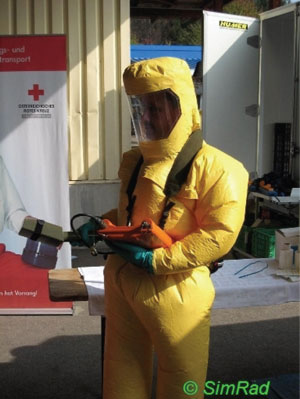by Gerhard Chroust, Karin Rainer and Markus Roth
In responding to the growing need to be prepared for chemical, biological, radiological and nuclear (CBRN) emergencies, First Responders (i.e. fire brigades, emergency medical services and police) must quickly evaluate such incidents and take appropriate actions to minimize negative effects on humans and goods. Achieving such interventions poses a critical challenge, since humans do not possess any inborn, natural sensors with which to recognize these dangers early enough. Additionally they are not equipped with natural, semi-autonomous reaction patterns. Nevertheless, it is of the utmost importance to avoid endangering the First Responders. This requires special training and adequate tools, especially since a considerable proportion of First Responders are volunteers providing part-time services.

Protected First Responder testing contamination (Photo: SIMRAD).
The SimRad (Simulation- and information system to manage Rescue units at disaster) projects, supported as part of the Austrian KIRAS programme for safeguarding Austrian critical infrastructures, have as their prime objective the conceptualization, specification and design of models, methods and tools for training First Responders concerned with CBRN emergencies. The results of these projects can also be applied in real assignments. The first phase, SIMRAD.NBC, which finished successfully in October 2009, provides the basis for a user- and practice-oriented training environment using state-of-the-art technologies and taking into account an up-to-date inventory of the needs of First Responders. The major issues identified and discussed were:
Characteristics of CBRN incidents and emergencies: CBRN incidents differ considerably from other incidents, due to the different nature of the origin and the behaviour of the sources of dangers (usually contaminants without directly observable menace).
Requirements for interventions in CBRN emergency situations: understanding the needs and requirements of First Responders is a key to implementing adequate support and training systems. A survey of First Responders identified and clarified prerequisites for a usable system.
Process-oriented view of interventions: an intervention is a network of processes, which may be serialized, interdependent or parallel. A process view provides detailed identification, analysis and evaluation of key processes for focused training possibilities.
Process description language: the heterogeneity and diversity of First Responders on a basic operational level requires a detailed description of the individual processes with an appropriate prescriptive language. Such a language allows systems to be built efficiently and with fewer misunderstandings, showing new ways of collaboration. It provides system builders with the opportunity to codify the knowledge of domain experts and to review the resulting systems,
Assessment of intervention processes: a consequence and benefit of the process view is the ability to assess quality aspects of individual intervention sub-processes for comparison and improvement by proposing best practices.
Organizational needs: successful interventions depend strongly on organization. Communication between different levels of hierarchy and cooperating units can become a crucial issue; gaps in communication and their circumvention were therefore investigated. According to expert opinion there is a big potential as well as a pressing need for structuring, clarifying and standardization in communication flow on these multiple levels.
SimRad framework: an effective, robust and flexible software framework is needed for training and for support of real action. It must be modular, so that various training and/or planning modules can be ‘plugged in’ depending on available facilities and actual and changing needs. Real-time evaluation and effortless change of these modules is necessary. In order to provide humans with flexibility, the SimRad framework is able to learn from current situations and from its users. This framework is designed to be compatible with existing devices and systems that are in use by First Responders and even by broader target groups like providers of critical infrastructure.
Simulation of interventions (mixed and augmented realities): simulation is a proven method for training and planning (cf flight simulators) offering repeatability, controllability and the possibility for evaluation. With respect to the often invisible and for human senses unnoticeable dangers of CBRN incidents, simulation allows dangerous situations and materials to be replaced by harmless ones. Mixed and augmented Reality software plays a key role in such simulations.
Human aspects: well-trained and experienced emergency personnel are crucial to a successful intervention. A series of interviews among experts provided information on positive or negative influences (motivators and stressors) affecting the ability to take proper action. Needs and views were analysed by considering organizational and human factors, equipment and methods for deployment. For volunteers in particular, the provision of interesting and challenging tasks in training settings is a strong source of motivation.
Systemic considerations: CBRN emergency situations involve highly complex and somewhat opaque processes having wide ramifications, showing often surprising immanent dynamic behaviour. The interplay of various activities and actors needs synergistic and/or interdependent views. Different types of progression and impact of catastrophes were investigated.
SimRad.COMP, the current project, began in October 2009 and will continue until 2011. It is based on the results of SIMRAD.NBC and will elaborate the specification for an appropriate software platform and support environment. This will include the concepts for marketable products (eg simulation and/or evaluation software) that are compatible with and supported by the SimRad framework. SimRad.COMP is supported by the Austrian Federal Ministry for Transport, Innovation and Technology (BMVIT) within the KIRAS Security Research Programme.
Links:
SimRad: http://www.simrad.at
KIRAS: http://www.kiras.at
Please contact:
Peter Ziehesberger
Ziehesberger Elektronik, Austria
E-mail:
Nadine Sturm
Research Institute of the Red Cross, Austria
E-mail:










